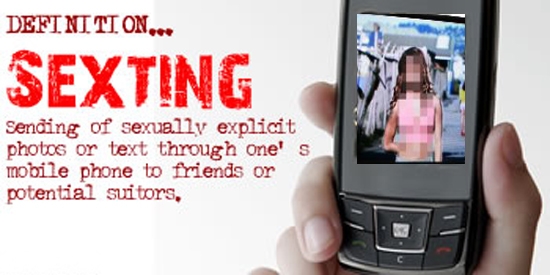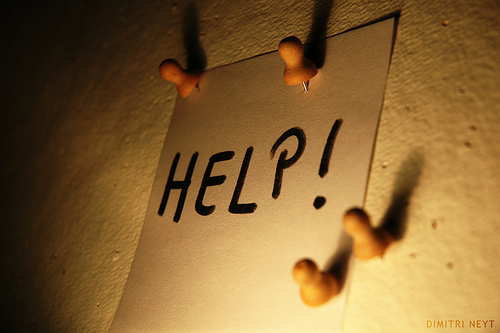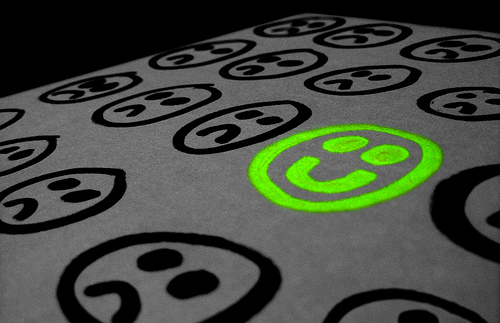In this month’s “Rolling Stone,” the magazine published an article called “Kiki Kannibal: The Girl Who Played With Fire”. The article tells the story of a 14-year-old teen in Florida who used MySpace to create a digital persona that attracted a lot of attention. An insecure and awkward teenager, Kirsten used MySpace to perform a confident, sexy persona named Kiki, sharing artistic photos that reveal a lot of skin. Not surprisingly, her sexy digital persona attracts a lot of attention – good, bad, and ugly. On one hand, she loves the validation; on the other, the stalking and personal attacks get increasingly severe and scary. This article raises all sorts of issues, in addition to those concerning attention, including sexual victimization (by a mentally unstable 18-year-old that she was dating), parental engagement (her parents encouraged her online participation as a depression-reducing strategy), and exploitation (by websites who profit off of drama). The story itself is actually quite complex, messy, and peculiar. It’s also quite clear that there’s a whole lot more to the story than what the journalist is able to pack into an article. Before Rolling Stone shut down the comments, people who said that they knew Kiki were commenting about how Kiki was more a bully than a victim and the self-declared mother of her now-dead ex was saying some fairly inflammatory things about Kiki. But in some senses, the details matter less than the overarching messy portrait. There are many fascinating aspects of this story and the ways in which it complicates how we think about teens and digital activities, but I want to drill down into the social factors involved in celebritization.

Part 1: Everyday Participation in the Attention Economy
As information swirls all around us, we have begun to build an attention economy where the value of a piece of content is driven by how much attention it can attract and sustain. It’s all about eyeballs, especially when advertising is involved. Countless social media consultants are swarming around Web2.0, trying to help organizations increase their status and profitability in the attention economy. But the attention economy doesn’t just affect the monetization of web properties; it’s increasingly shaping how people interact with one another.
Teens’ desire for attention is not new. Teens have always looked for attention and validation from others – parents, peers, and high-status individuals. And just as many in business argue that there’s no such thing as bad publicity, there are plenty of teens who believe that there’s no such thing as bad attention. The notion of an “attention whore” predates the internet. Likewise, the notion that a child might “act out” is recognized as being a call for attention. And it’s important to highlight that the gendered aspects of these tropes are reinforced online.
So what happens when a teen who is predisposed to seeking attention gets access to the tools of the attention economy? Needless to say, we see both exciting and horrifying events play out. We see teens like Tavi Gevinson propel her interest in fashion into a full-blown career before the age of 14. And we see countless teens replicating the trainwreck activities of Britney Spears, Lindsay Lohan, and other celebrities. When teens leverage social media to propel themselves into the spotlight, they fully (and with reckless abandon) engage in a set of practices that Terri Senft and Alice Marwick talk about as micro-celebrity. They work to manage their impressions, cultivate attention, and interact in ways that will increase their fame and social status.
Like it or not, the culture that we live in is saturated with narratives of celebrity success and celebrity failure. It’s downright hard to avoid Charlie Sheen’s meltdown or Kate Middleton’s wedding. With the rise of reality TV and the unfolding of major social media, individuals have felt closer than ever to the possibilities of celebrity. Celebrity becomes a correlate to a perfect life- money, designer clothes, and adulthood. What being a ‘celebrity’ means is discarded; fame is an end to itself with the assumption that fame equals all things awesome despite all the copious examples to the contrary. So teens only hold on to the positive aspects, hoping for the benefits of becoming famous and ignoring the consequences.
Kiki’s story is all about the celebritization of everyday life. She leveraged social media – and her image as a sexy young woman – to capture widespread attention. She turned herself into a commodity, and commoditized her popularity through her jewelry store. And the more attention she captured, the more she faced the benefits and costs of celebrity. Like her more famous peers – folks like Miley Cyrus and Demi Lovato – Kiki attracted both fans and haters. But what’s different is that Lovato’s fame has come with a fortune and a whole lot of handlers; Kiki lacked the resources to handle the onslaught and never made it big enough to recoup the ground she lost to weather the fame.
To complicate matters more, Kiki is engaged in a set of attention-seeking practices that make most adults nervous. She’s not capturing massive attention through being a clean-cut geek, like Rebecca Black (of “Friday” fame). And she’s not the center of a controversy for violating social norms, like Alexandra Wallace (of “Asians in the Library” fame). Instead, she’s using her image and her creativity to express herself as a sexy young woman in a sex-saturated society that hypocritically loves sexualized imagery and deplores young women who engage in it. This leaves her in an awkward and tenuous position – she’s successful at attracting attention but, because it’s outside of the media machine and involves the tropes of underage sexuality, she’s also under attack and not defended.
Part 2: The Toxicity of Fame
In reading Kiki’s story, it’s hard not to wonder why she doesn’t just walk away from her digital persona. Sure, her digital business – which depends on her celebritization – would falter (and there are some interesting implications in this wrt her family’s limited resources). But if the cruelty is so psychologically harmful, is it really worth it?
For years, I worked for V-Day, an organization committed to ending violence against women and girls. I’ve met countless women who continually return to abusive relationships because the highs make the lows worth it. My own experiences required me to constantly push back against the voice in my head that said: “this time will be different, right?” Again, it comes down to attention. Being showered with love feels so good that it’s often easy to forget the bad days. There are countless reasons behind why those in abusive relationships stay in them, but one things clear: walking away from an abusive relationship is never easy.
Life in the spotlight can easily take the form of an abusive relationship. When the attention is good, it’s really good and it feels really good. And when the attention fades, people can feel lonely and anxious, desperate for more, even if it’s negative attention. But when the attention gets negative, things can easily spiral out of control. There are countless examples of celebrities for whom fame is a toxic substance. There’s always a cost to the attention. Herein lies a challenge… is the fame worth it?
Personally, I’ve always struggled with this. I have the great fortune of being highly visible and the rewards of my micro-fame have been tremendous. But I can’t say it’s been easy or that it’s always fun. It’s hard to stomach photoshopped images and cruel comments. And people aren’t always kind when they think that I don’t deserve the attention I’ve gotten. But, all things told, I have it pretty good. I’m confident in who I am; I have a successful career; and my haters aren’t that vicious. But I’ve managed to achieve enough attention to be wary of it and to appreciate how toxic and cruel a substance it can be. And there are certainly times when I find myself slipping into a pattern that I know so well, where I feel like my relationship with the internet has the same cycles of some of my more abusive relationships.
I’m not convinced that people of any age are well equipped to handle fame, let alone the cruel cycles that can come with it. Certainly, experience makes it easier to stomach, but Charlie Sheen’s meltdown should make it crystal clear that it’s not just teen girls who struggle with the spotlight. The thing about youth is that they often crave celebrity a lot more than adults. And their mental images of what it means are often distorted. So many teens that I interviewed over the years have talked about fame as freedom, failing to recognize the constraints that come with those golden handcuffs.
Kiki is living in a whirlwind of fame, attention, and commodification. She’s turned herself into someone to watch and those who are watching are asserting power over her in deeply problematic ways. She’s created a digital icon but her audience has objectified her, failing to recognize or value the person behind the icon. This puts her in a peculiar place with limited control. And that would be the precise location of celebrity.
I suspect we are going to see more and more stories of individuals who have wanted celebrity to more or lesser degrees and who are sucked into a tumultuous relationship with fame. And I suspect the public will swing between feeling sympathy for their plight and blaming them for putting themselves out there. This is certainly the case with respect to those brought into the public eye through reality TV and tabloid magazines, and even those who are fired from jobs or kicked out of school for what they post on Facebook or Twitter. But I fear that our collective objectification of very visible people is also going to get much worse as more individuals come to prominence online. And many of those for whom the worst vitriol is reserved are young women, especially those who transgress the social boundaries of what it means to be nice or sexually appropriate. Internet commenting makes it easy to spew venom towards those in the crosshairs of celebrity, but we should recognize this isn’t simply a position to be envied. Just because people benefit from being visible doesn’t mean that they have the wherewithal to stomach the attacks. At the same time, just because celebrity is an option doesn’t mean that it’s a healthy one.
Widespread celebritization is the flipside of the “attention economy” coin and I think that we have a lot of deep thinking to do about the implications of both of these. Both are already rattling society in unexpected ways and I’m not convinced that we have the social, psychological, or cultural infrastructure to manage what will unfold. Some people will become famous or rich. Others will commit suicide or drown attempting to swim in these rocky waves. This doesn’t mean that we should blockade the technologies that are emerging, but it’s high time that we start reflecting on the societal values that are getting magnified by them.
[This post wouldn’t have been possible without the help Alice Marwick, Mary Gray, and Mike Ananny.]
 In a cultural context where Congressman Anthony Weiner foolishly published salacious content on Twitter, it’s hard to ignore sexting as a cultural phenomenon. Countless adults send sexually explicit content to one another, either as acts of flirtation or more explicit sex acts. And yet, when teenagers do so, new issues emerge. Teen sexting gets complicated, especially when images or videos are involved, because it butts up against child pornography laws. Unfortunately, teens have been arrested on child pornography charges for taking or sharing images of themselves or their peers.
In a cultural context where Congressman Anthony Weiner foolishly published salacious content on Twitter, it’s hard to ignore sexting as a cultural phenomenon. Countless adults send sexually explicit content to one another, either as acts of flirtation or more explicit sex acts. And yet, when teenagers do so, new issues emerge. Teen sexting gets complicated, especially when images or videos are involved, because it butts up against child pornography laws. Unfortunately, teens have been arrested on child pornography charges for taking or sharing images of themselves or their peers.




